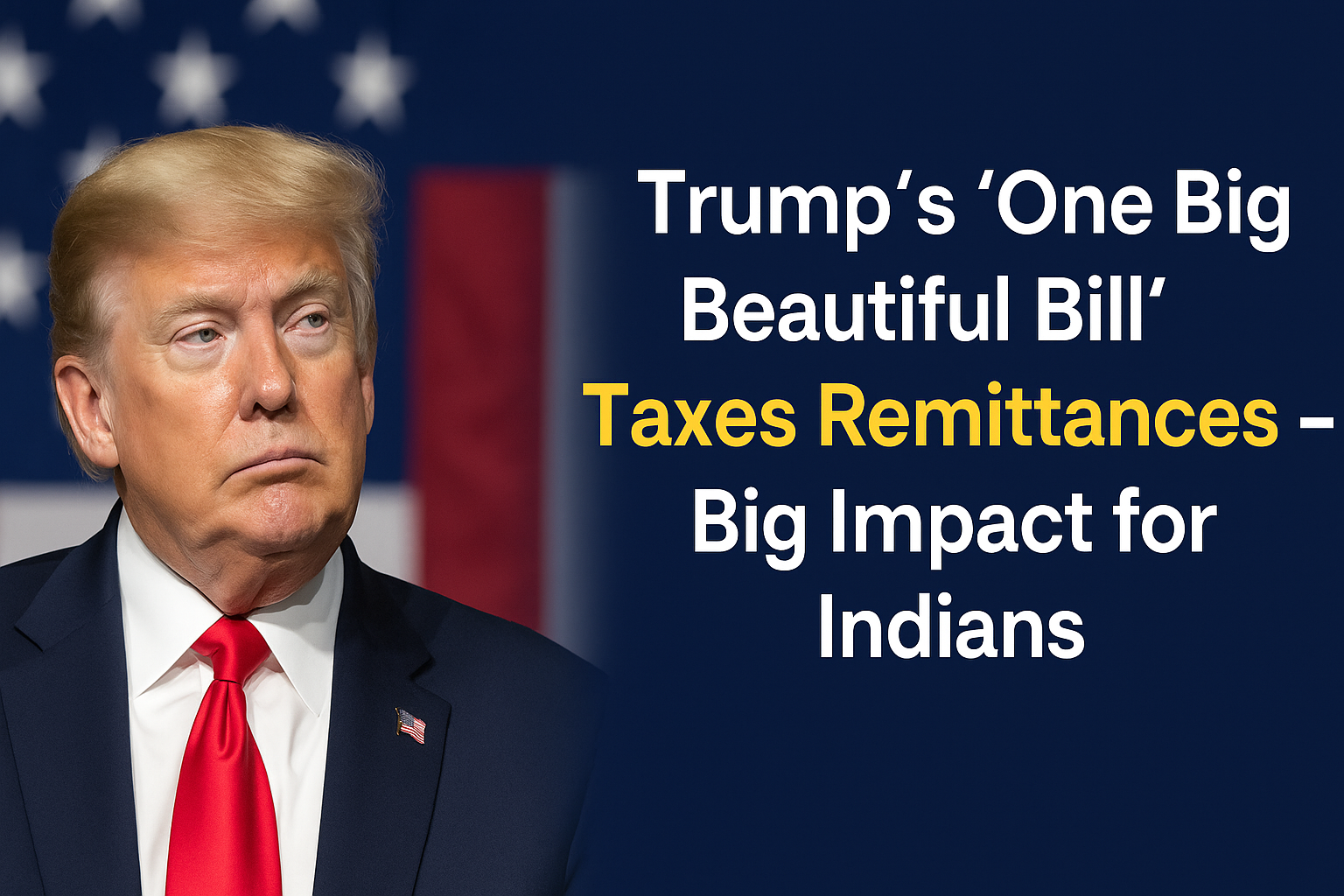Introduction
Former U.S. President Donald Trump, currently campaigning for re-election, has revived a controversial proposal that could have significant ripple effects worldwide — especially for countries like India. Touted as part of his immigration control agenda, Trump has proposed a “One Big Beautiful Bill” that includes taxing remittances sent by undocumented immigrants to their home countries.
While primarily aimed at Mexico, the broader implications of such a remittance tax could extend to many other countries — India included — particularly if the policy expands to cover all foreign remittances regardless of the sender’s immigration status.
This blog explores how this proposed bill could impact:
- Indians living in the U.S. (both documented and undocumented)
- Families receiving money in India
- India’s economy and forex reserves
- Exporters, service providers, and students dependent on U.S. funds
What Is Trump’s “One Big Beautiful Bill”?
Trump’s proposal includes measures to:
- Impose a fee or tax on remittance payments sent by undocumented immigrants.
- Use the revenue to fund border security, notably the construction of the Mexico border wall.
- Potentially expand taxation to all outward remittances, regardless of sender status, to increase revenue.
Though pitched primarily as a measure against illegal immigration, such policies can evolve into broader financial regulations that affect millions of legal immigrants, including Indian citizens residing in the U.S. under H1B, L1, F1, and even green card categories.
Why This Matters to Indians
India is the largest recipient of remittances in the world, with over $125 billion received in 2023, according to the World Bank. A significant portion of this comes from the United States.
1. For Indian Families:
A remittance tax means:
- Reduced income support for families in India.
- Higher costs for routine transfers (e.g., tuition fees, medical expenses).
- Likely burden passed on by money transfer operators via increased service charges.
2. For Indian Students:
- U.S.-based relatives who send funds to Indian students may face disincentives due to taxes.
- It could lead to a drop in overseas education funding, impacting Indian institutions and students.
3. For Indian Exporters & Freelancers:
- Many Indian service providers and freelancers receive payments from U.S. clients via remittance channels.
- Any tax on such payments could affect profit margins, delay transactions, or trigger compliance issues.
4. For India’s Forex Reserves:
- A decrease in inflows from the U.S. could dent India’s foreign exchange reserves.
- This would impact the exchange rate, trade deficits, and India’s macroeconomic stability.
The Legal and Technical Challenge
Trump’s proposal may face constitutional and logistical hurdles, including:
- Opposition from financial institutions and remittance platforms like Western Union and MoneyGram.
- Pushback from immigrant communities and human rights groups.
- Legal challenges on discrimination and unequal treatment.
However, if passed and implemented even partially, it would encourage alternative, possibly illegal channels for money transfer — increasing financial opacity and reducing traceability.
Global Remittance Trends and India’s Exposure
| Country | Remittance to India (2023) | Share in Total |
|---|---|---|
| USA | $26 billion | ~21% |
| UAE | $19 billion | ~15% |
| Saudi Arabia | $10 billion | ~8% |
| UK | $9 billion | ~7% |
| Canada | $7 billion | ~5% |
India’s heavy reliance on remittances from the U.S. makes any U.S. regulatory move highly impactful.
Policy Response India Should Consider
If Trump’s proposal advances, India needs to prepare by:
- Bilateral Dialogue: Open a diplomatic channel to ensure Indian remittances aren’t unfairly targeted.
- Alternative Channels: Strengthen digital and government-facilitated remittance options like RuPay and UPI cross-border.
- Financial Literacy Campaigns: Educate NRIs and their families about compliant, low-cost money transfer methods.
- Contingency Planning: Brace for potential foreign exchange inflow fluctuations in economic forecasting.
How Exporters Should Respond
Indian exporters, especially in the services sector, should:
- Shift to invoice-based B2B bank transactions rather than informal remittance transfers.
- Consider opening international accounts with Indian banks operating abroad (e.g., ICICI Bank USA, SBI New York).
- Track political developments in U.S. policy closely and hedge currency risk where feasible.
Conclusion
Trump’s proposed remittance tax may seem like a niche immigration tactic, but its global consequences are anything but small. For India, the world’s largest recipient of foreign remittances, the policy could shake household budgets, strain foreign reserves, and impact sectors like education, IT, and exports.
Whether or not the bill passes, this development highlights the importance of diversifying financial inflows, creating secure and legal remittance pathways, and staying politically aware in a deeply interconnected world.
📌 Key Takeaways:
- Trump’s proposed bill aims to tax remittances sent by undocumented immigrants.
- India may be impacted if the policy is extended to all foreign transfers.
- Families, students, and freelancers could bear the brunt.
- Exporters and the Indian government must act proactively.
- Diversification and diplomacy are crucial to navigate the threat.




